📺Eyes on the Screen: WSL Broadcast and Streaming Trends 2024-25
How YouTube changed the game, why Sky audiences dropped, and what the 2024–25 WSL season tells us about the future of women's football broadcasting.
Introduction
The 2024-25 Barclays Women's Super League marked a watershed moment in sports broadcasting. While traditional television audiences declined by 35%, the league achieved remarkable digital milestones: becoming the second-most watched women's sports property globally on YouTube and securing the highest TikTok engagement per video of any major women's league worldwide.
This wasn't a step backward—it was a strategic leap forward. The WSL's transition from the FA Player to YouTube for live streaming, combined with explosive social media growth, signals a fundamental shift in how modern audiences consume women's football. The data tells a story of adaptation, innovation, and the emergence of a truly multi-platform entertainment property.
Bottom Line Up Front: Despite traditional TV declines, the WSL strengthened its position as a global digital powerhouse, setting the foundation for sustainable growth in an increasingly fragmented media landscape.
The Linear Television Reality Check 📉
The 35% Decline: Context and Causes
Traditional television viewership dropped from 261k to 169k average viewers per match—a steep 35% decline that demands examination. However, this wasn't unique to women's football: men's Premier League audiences also fell 9% year-on-year, indicating broader shifts in viewing habits rather than declining interest in the WSL specifically.
The decline wasn't uniform across all platforms. BBC One remained remarkably stable, averaging 682k viewers per match (only -2% from 2023-24), proving that free-to-air accessibility continues to drive substantial audiences. The primary drop occurred on Sky Sports channels, where the average fell from 396k to 337k (-15%).
Channel Performance: Winners and Losers
BBC One: The Consistent Performer
Averaged 682k viewers across 3 matches
Maintained 47 minutes average viewing time
Proved the power of free-to-air broadcasting for major fixtures
Sky Sports: Facing New Challenges
The most significant factor? Scheduling and competition. WSL matches faced increased competition from higher-profile sports during weekend slots, with Premier League coverage, Formula 1, and darts all seeing substantial growth on Sky Sports Main Event during WSL broadcast windows.
The Scheduling Puzzle: Competition and Timing ⏰
International Breaks: The WSL's Sweet Spot
One of the season's clearest patterns emerged during men's international breaks. WSL matches broadcast during EPL international breaks averaged 122k viewers on Sky, compared to just 88k when competing against domestic men's football—a 39% boost that highlights the importance of strategic scheduling.
The data reveals three international break weekends in 2024-25 produced some of the season's highest individual match audiences, suggesting the WSL benefits significantly when it has the football stage to itself.
The Manchester United Paradox
Perhaps nowhere is the complexity of modern sports viewing more evident than in Manchester United Women's broadcast performance. Despite 60% more live linear broadcasts (rising from 10 to 16 matches), their average audience per match actually declined.
The Competition Effect: United Women's matches performed notably better when the men's team wasn't playing the same weekend. When both teams were broadcast simultaneously—particularly the Brighton clash that aired directly against United Men vs Fulham on TNT—audiences dropped to 96k, well below their season average of 116k.
Timeslot Performance: The Sunday Evening Magic
Sunday evening emerged as the premium slot for WSL broadcasting, averaging 144k viewers per match on Sky—the highest of any regular timeslot. However, this created an interesting tension: Sunday evening delivered the best TV audiences but lowest stadium attendance (5,371 average), highlighting the ongoing challenge of optimizing for both broadcast and live attendance.
Arsenal vs Chelsea: The Marquee Moment ⚽
The season's highest-rated broadcast exemplified the WSL's potential when conditions align perfectly. Arsenal vs Chelsea drew 732k viewers on BBC One—benefiting from three crucial factors:
Free-to-air accessibility on BBC's flagship channel
International break weekend with no men's football competition
London Derby appeal between the league's two biggest draws
This London Derby became a template for maximizing WSL audiences, though notably it fell short of 2023-24's peak Manchester City vs Manchester United clash (813k viewers). The slight decline in marquee match audiences reflects the broader challenges facing traditional broadcasting.
Team Appeal: The Viewing Hierarchy 🏆
Arsenal Leads the Pack
Arsenal dominated broadcast appeal with an average of 260k viewers per match, establishing themselves as the WSL's premier television draw. Their consistent performance across both BBC (5 appearances) and Sky (9 appearances) matches proved their broad-based appeal.
The Universal Decline
Remarkably, every single team that competed in both 2023-24 and 2024-25 saw declining average audiences, ranging from Arsenal's manageable -12% to Leicester City's dramatic -83%. This universal trend reinforces that external factors—rather than club-specific issues—drove the overall viewership decline.
Manchester United's -64% drop was particularly stark, falling from the league's most-watched team to eight place despite significantly increased coverage. This suggests that expanded exposure doesn't automatically translate to maintained audience levels in a crowded media landscape.
Digital Domination: The YouTube Revolution 🚀
From FA Player to Global Platform
The WSL's decision to move 70 live matches from the FA Player to YouTube proved transformative. The Barclays WSL YouTube channel achieved 39.6 million views in its inaugural season, immediately establishing itself as the second-highest viewed women's sports property globally behind only the WTA.
This wasn't just about reach—it was about engagement quality. Despite uploading 29% fewer videos than the previous season, views per video increased by 12%, indicating more compelling content and better algorithmic performance.
Social Media Supremacy
The WSL didn't just compete in digital spaces—it dominated them:
TikTok Excellence:
Highest views per video (417k) of any major women's sports league globally
Highest engagement per video worldwide
7th overall in total views despite posting the least content
The Quality Over Quantity Strategy
While leagues like NWSL posted 1,609 TikTok videos, the WSL uploaded just 281—yet achieved 417k average views per video compared to NWSL's 155k. This surgical approach to content creation proved far more effective than volume-based strategies.
Global Appeal: Beyond British Borders 🌍
International Audience Growth
YouTube analytics revealed the WSL's remarkable global penetration. Despite being a domestic English league, only 33.4% of YouTube viewership came from the UK. The remaining two-thirds came from:
This international appeal far exceeds other major women's leagues. Spain's Liga F draws 47.2% domestic viewership, while Mexico's Liga BBVA MX Femenil captures 68.3% of its audience domestically. The WSL's global reach positions it uniquely for international commercial opportunities.
Female Engagement: The Digital Advantage
Perhaps most significantly, female viewers spent an average of 26 minutes per month watching BWSL content on YouTube, compared to just 6 minutes for EPL content. During peak months, the WSL actually achieved higher total female viewing minutes than the Premier League on YouTube—a remarkable achievement that demonstrates the league's core audience loyalty.
Comparative Context: WSL vs. Other Sports 📊
Domestic Competition Performance
The WSL's digital transformation positioned it favorably against other UK sports properties:
Global Women's Sports Landscape
Internationally, the WSL established itself as a digital powerhouse:
The WSL's performance becomes even more impressive when considering it competes against established global leagues with longer digital histories and larger domestic populations.
Club Digital Performance: The New Hierarchy 📱
Chelsea's Social Media Dominance
While Arsenal led traditional TV viewership, Chelsea dominated social media engagement.
The Digital Success Stories
Several clubs achieved remarkable year-on-year social media growth:
TikTok Growth Leaders:
Combined WSL teams: +154% views YoY
Instagram engagement: +3% despite posting 2% less content
Platform Champions:
TikTok: Chelsea (258m views)
Instagram: Chelsea (42m engagements)
Facebook: Arsenal (explosive growth driven by UWCL celebrations)
Arsenal's Facebook success deserves special mention: their Women's Champions League celebration videos generated over 150 million views, with the changing room celebrations alone reaching 157 million views—demonstrating the power of authentic, emotional content.
Player Power: Individual Digital Influence 💪
TikTok's Rising Stars
Millie Turner emerged as the WSL's biggest TikTok star, accumulating 31.6 million views across 282 video uploads—more content than any other WSL player. Her most viral video alone generated 28.2 million views, proving individual players can drive massive engagement.
Instagram's Established Hierarchy
Lucy Bronze maintained her position as the WSL's most engaged Instagram personality with 4.3 million engagements, followed closely by Chloe Kelly (4.2m) and Alessia Russo (3.3m). Remarkably, 56% of active WSL players posted 20+ times on Instagram during the season, indicating high engagement across the player base.
The Championship Success Story 📈
While WSL traditional broadcasting faced challenges, the Women's Championship achieved remarkable growth. Attendance doubled to 2,086 per match (+108% YoY), and the league secured its first-ever Sky Sports broadcast with the title decider between Birmingham City and London City Lionesses drawing 18k viewers.
This success story reinforces that women's football's growth story extends beyond the top tier, with the Championship establishing itself as a viable broadcast property in its own right.
Key Takeaways
The 2024-25 WSL season revealed a league in transformation. While traditional television audiences declined, the digital revolution positioned the WSL as a global entertainment property with unprecedented reach and engagement. The move to YouTube, combined with explosive social media growth, created a sustainable foundation for future growth.
The data is clear: the future of women's football broadcasting is multi-platform, global, and engagement-driven. The WSL's digital-first approach hasn't just compensated for traditional TV declines—it's created new opportunities that didn't exist in the linear-only era.
As we look toward 2025-26, the WSL enters its new broadcast cycle not as a traditional sports property adapting to digital change, but as a digital-native entertainment brand that happens to be built around football. That distinction will define its next phase of growth.
This analysis is based on BARB linear-TV ratings, YouTube viewing data (via Tubular Labs), verified social-media metrics (Tubular Labs + Meta Content Library), and official WSL information, as compiled in the Women’s Sport Trust June 2025 Visibility Report covering the 2024-25 season (June 2024 – May 2025).
👋 Stay Connected
If you want weekly WSL insights, stat deep dives, and match previews, subscribe and share! We’d also love to hear your thoughts — reply or comment below 💬
Follow @WSLAnalytics on X for bite-sized stats and updates.


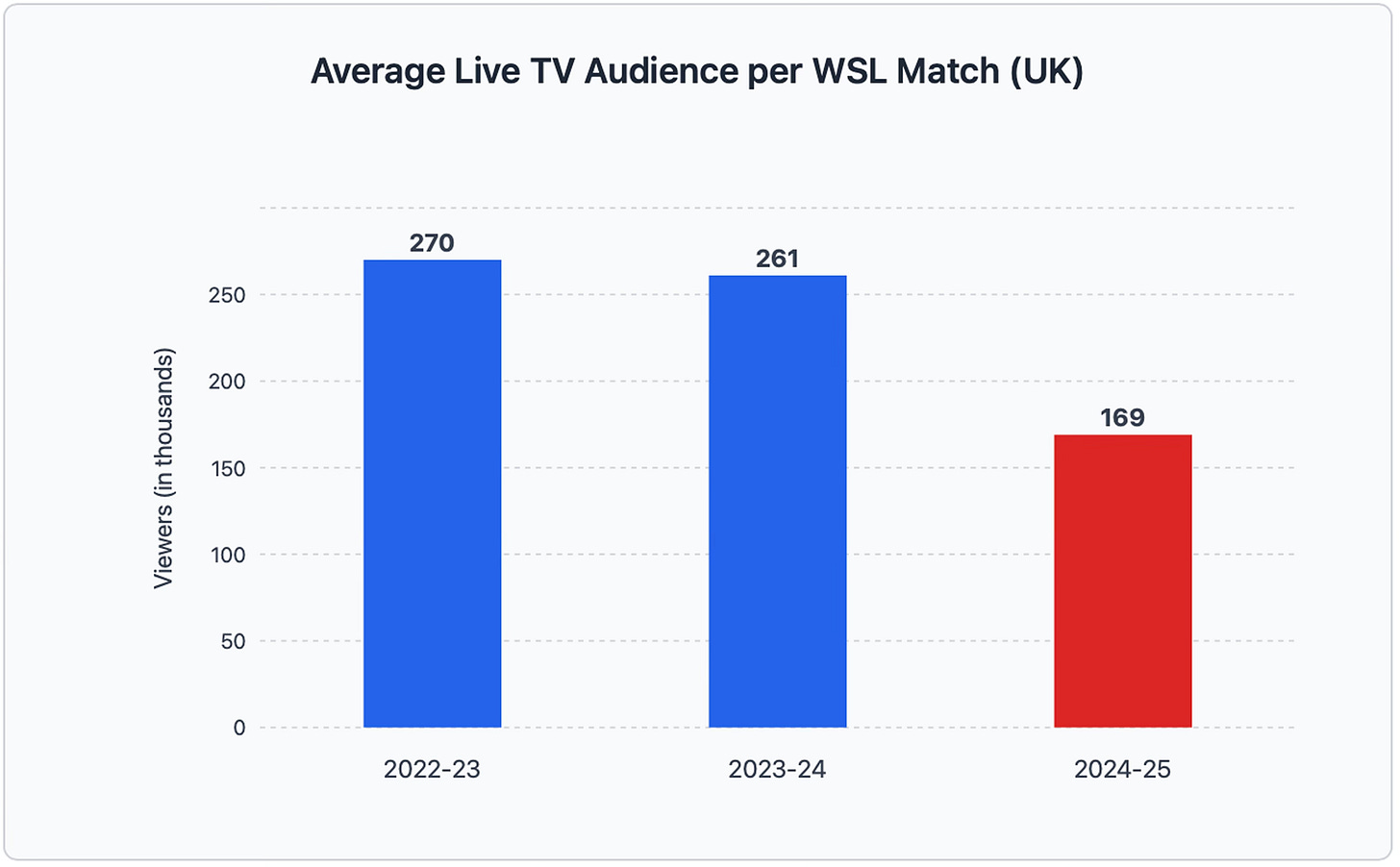
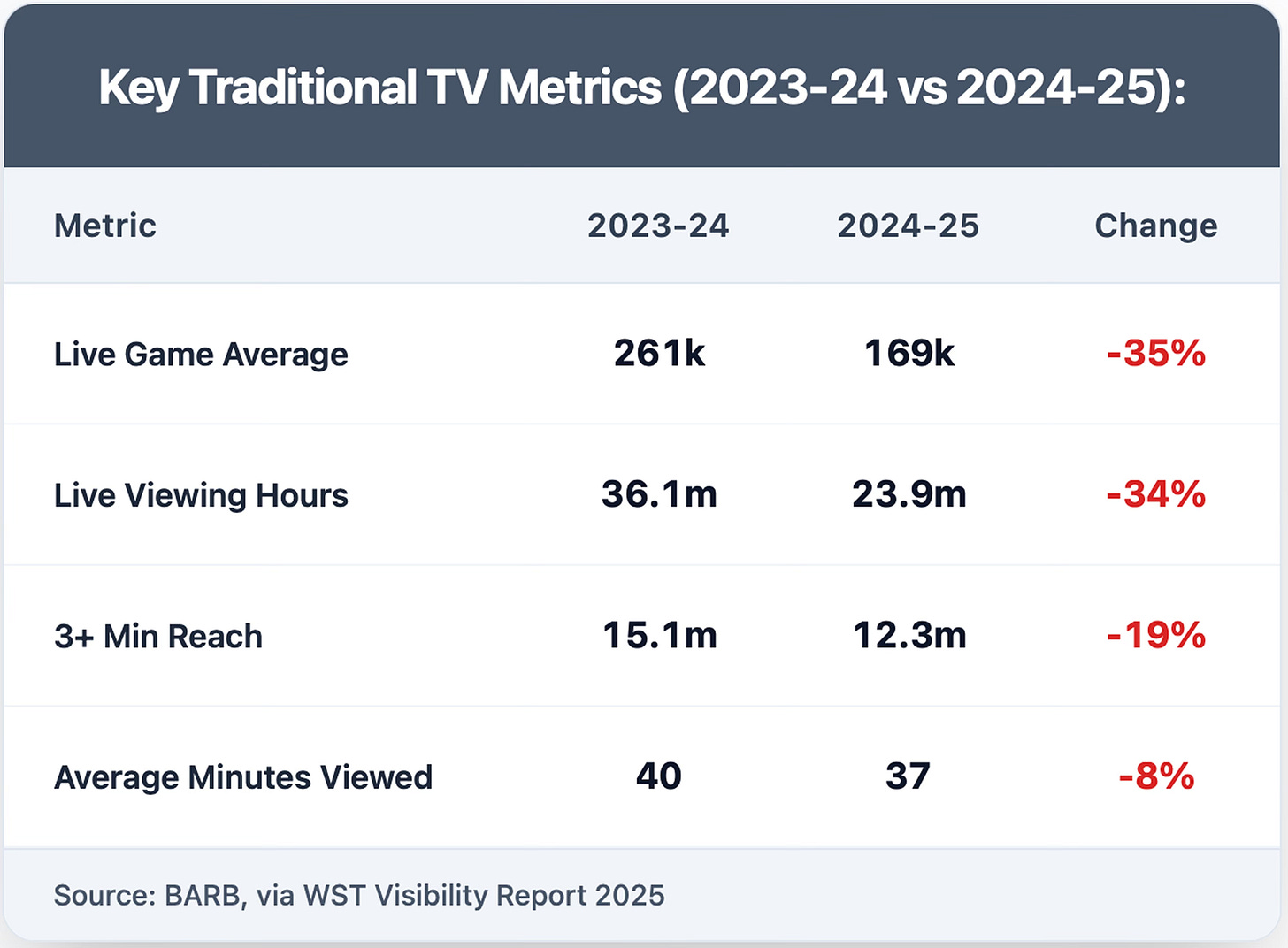
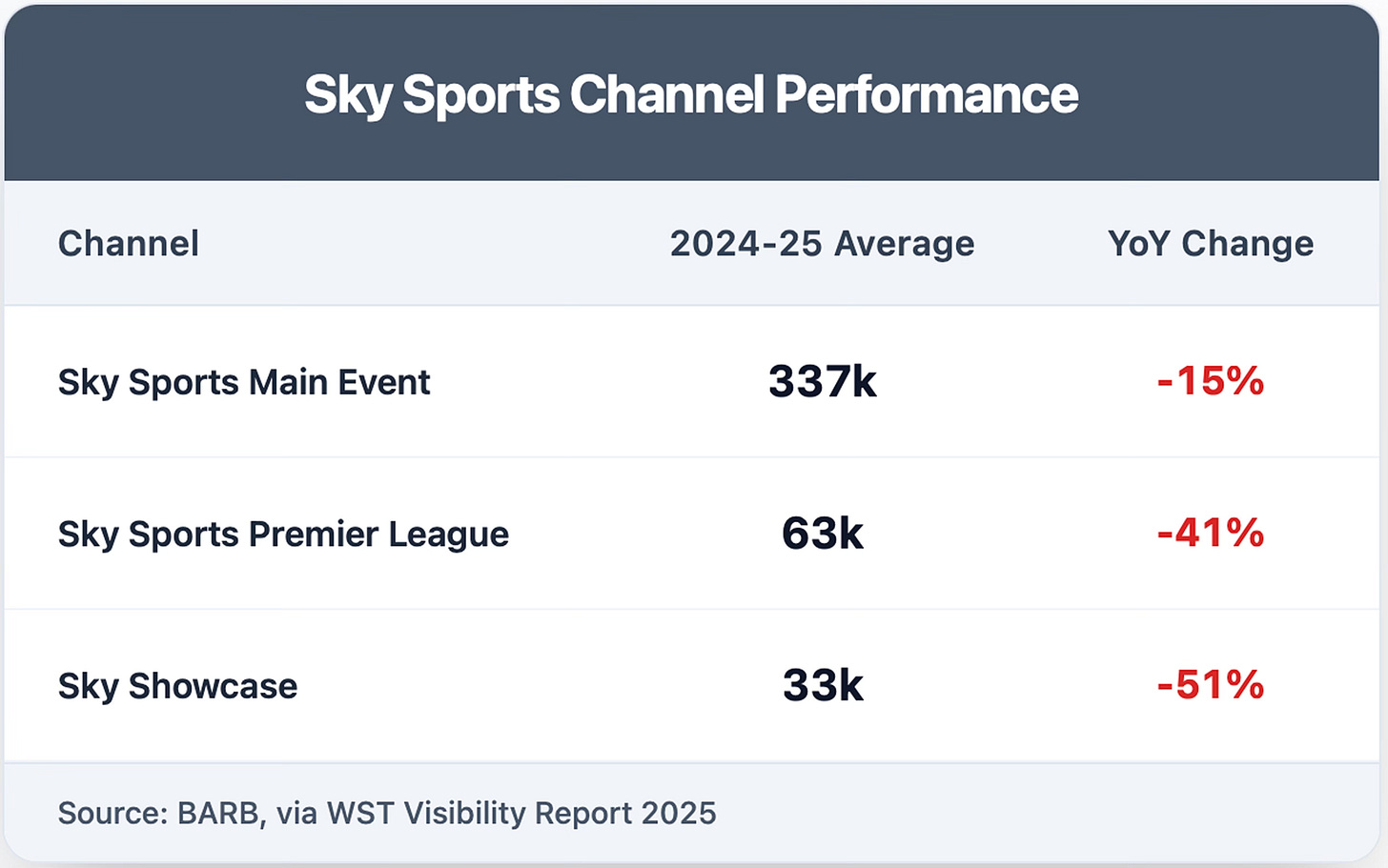
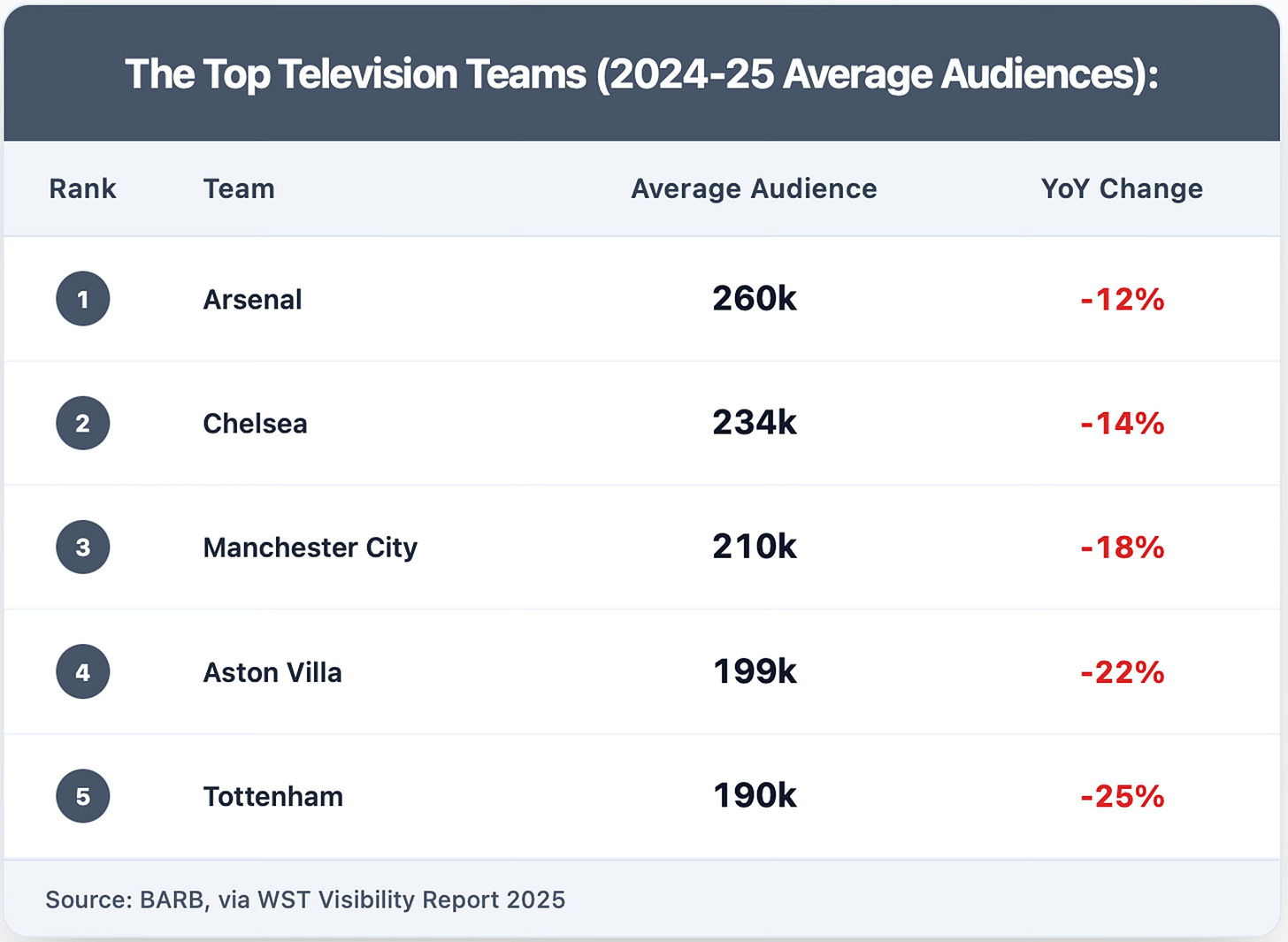
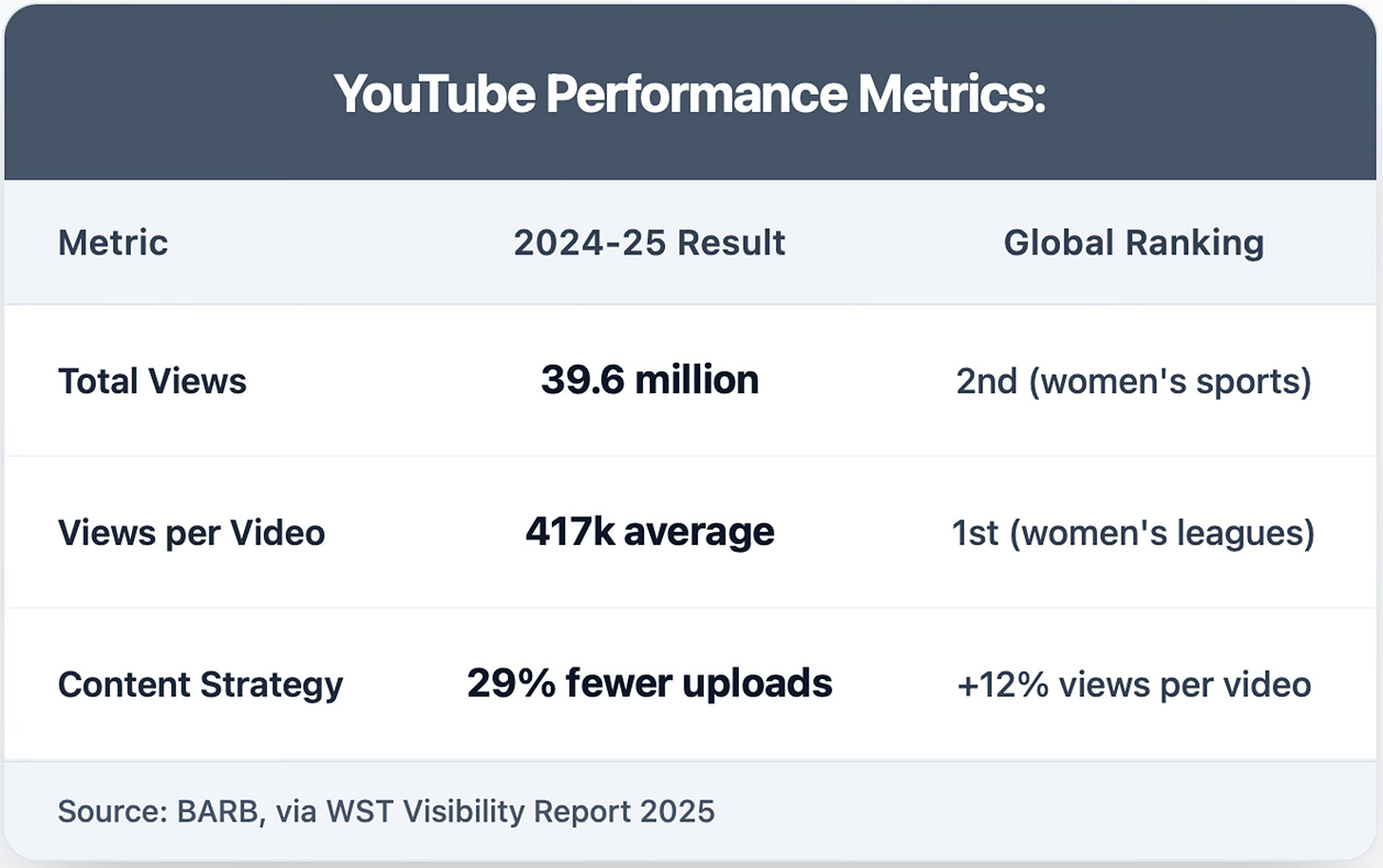
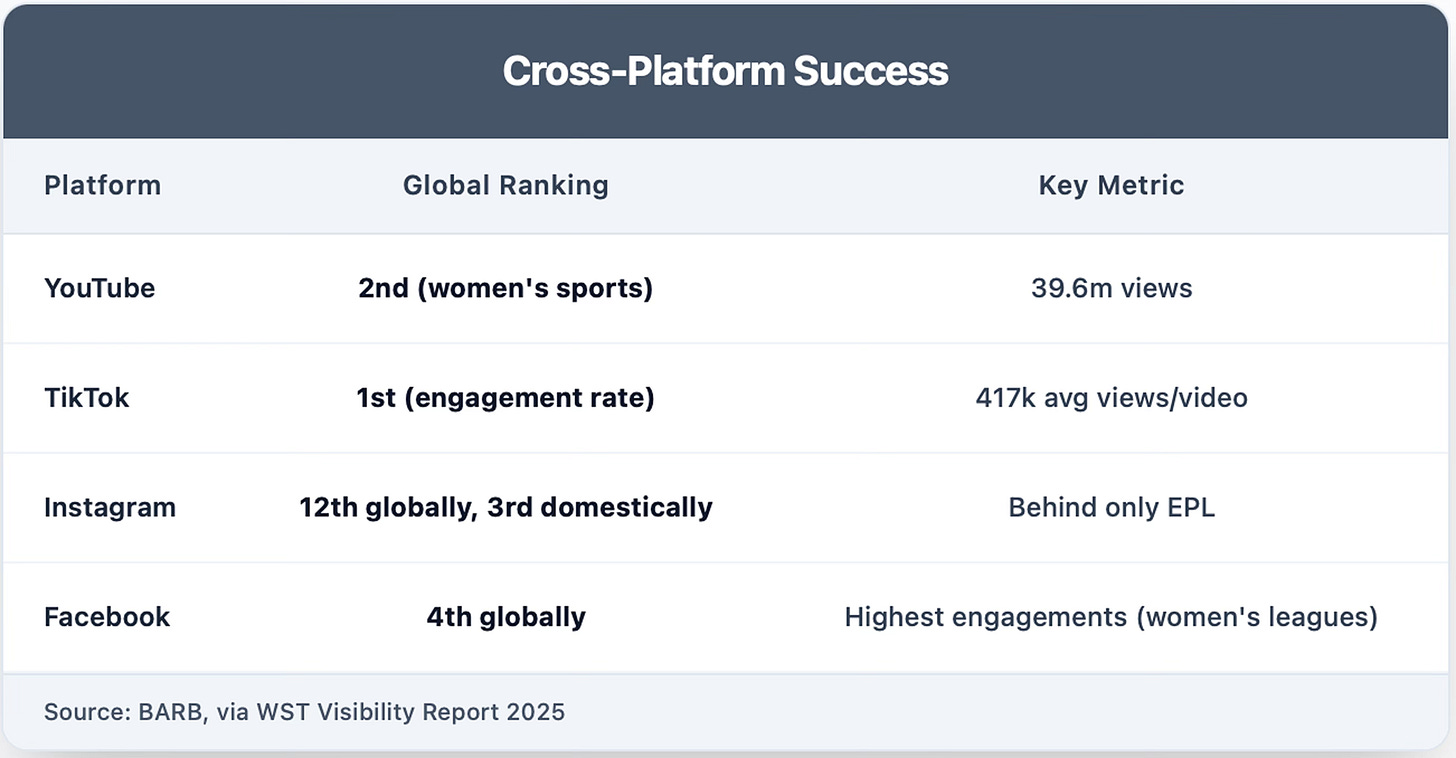
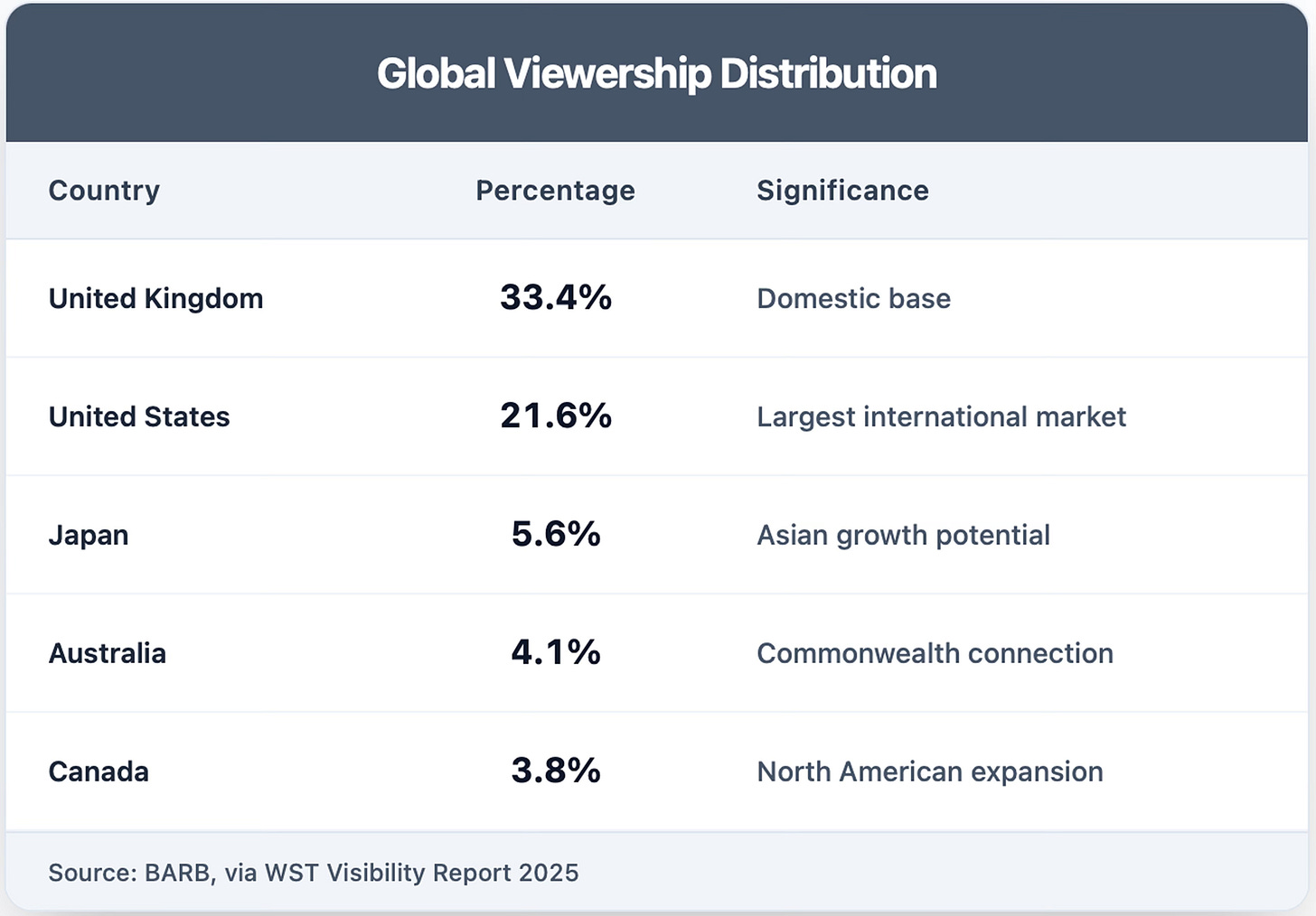
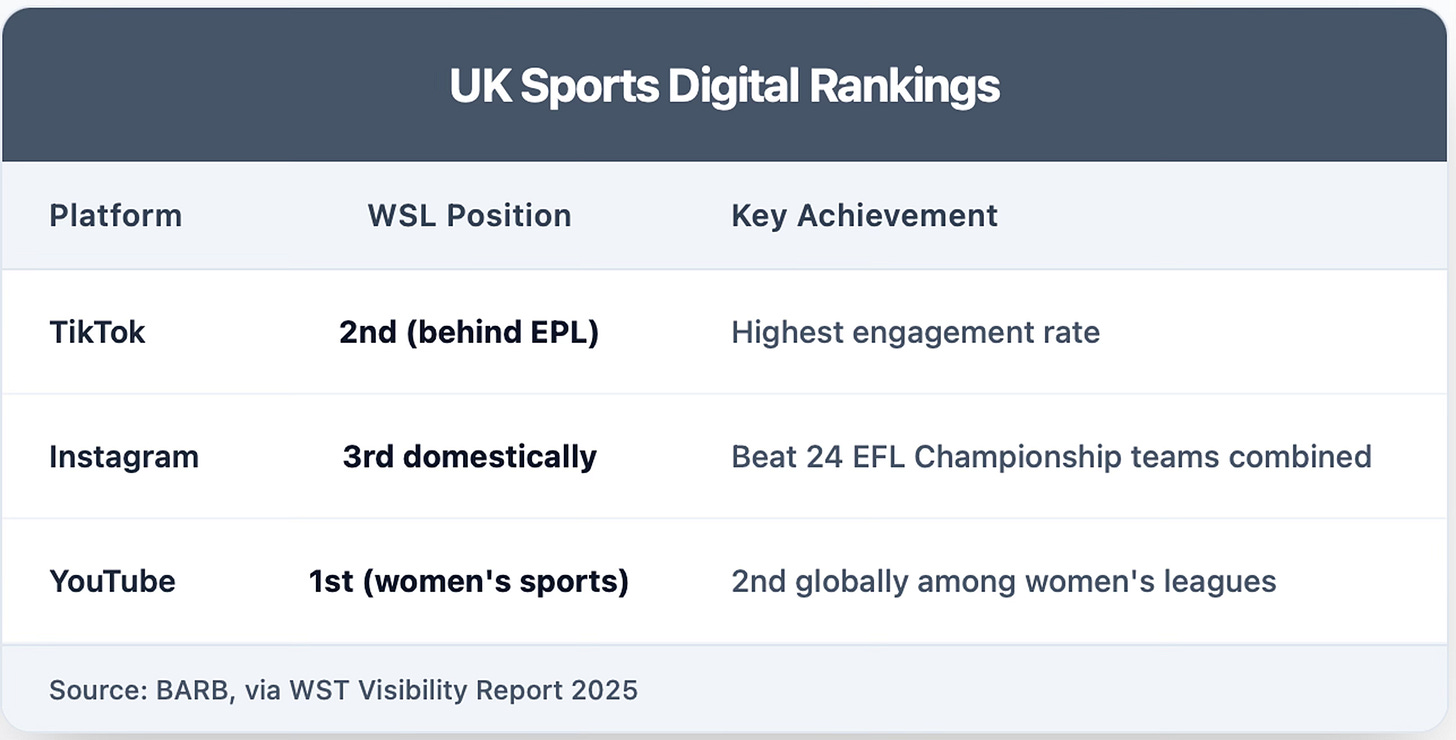
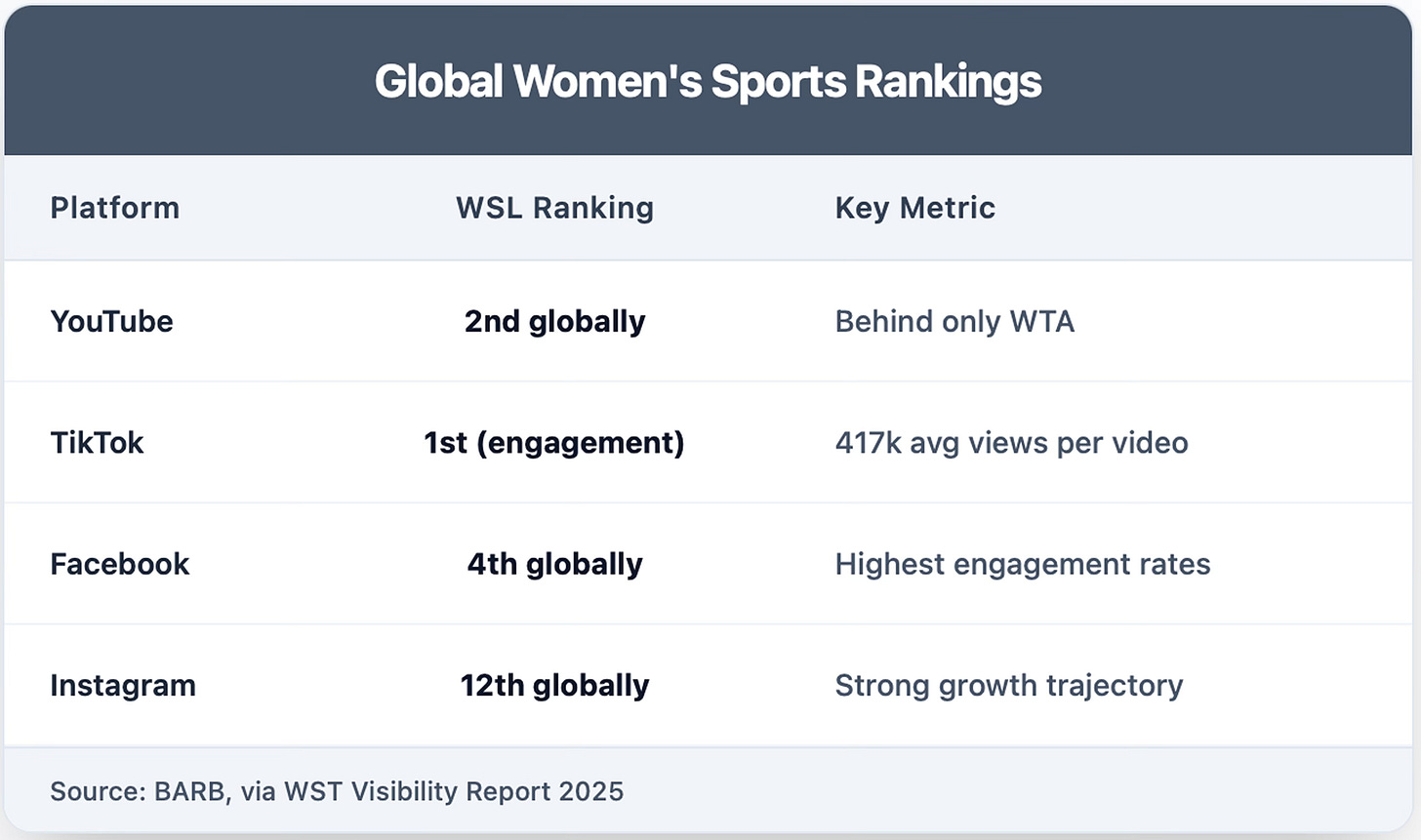
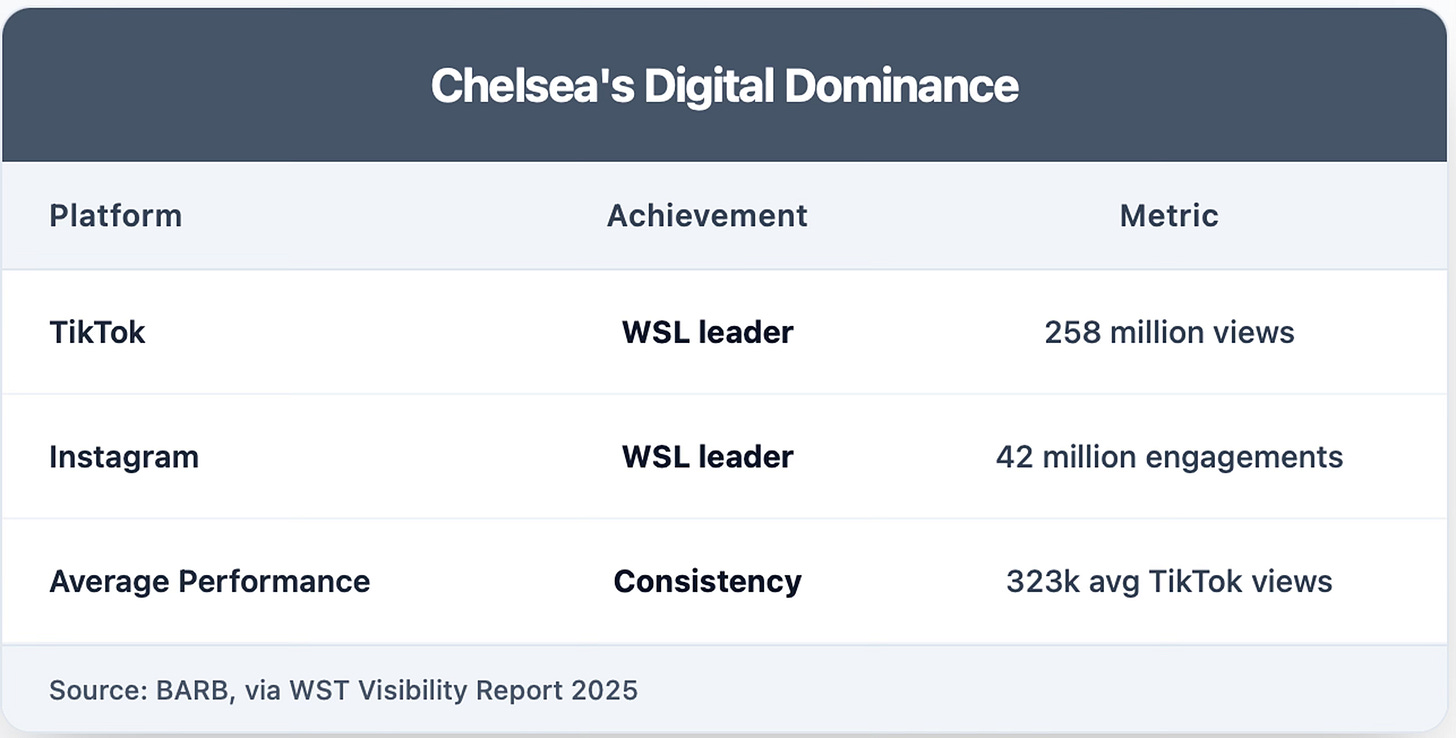
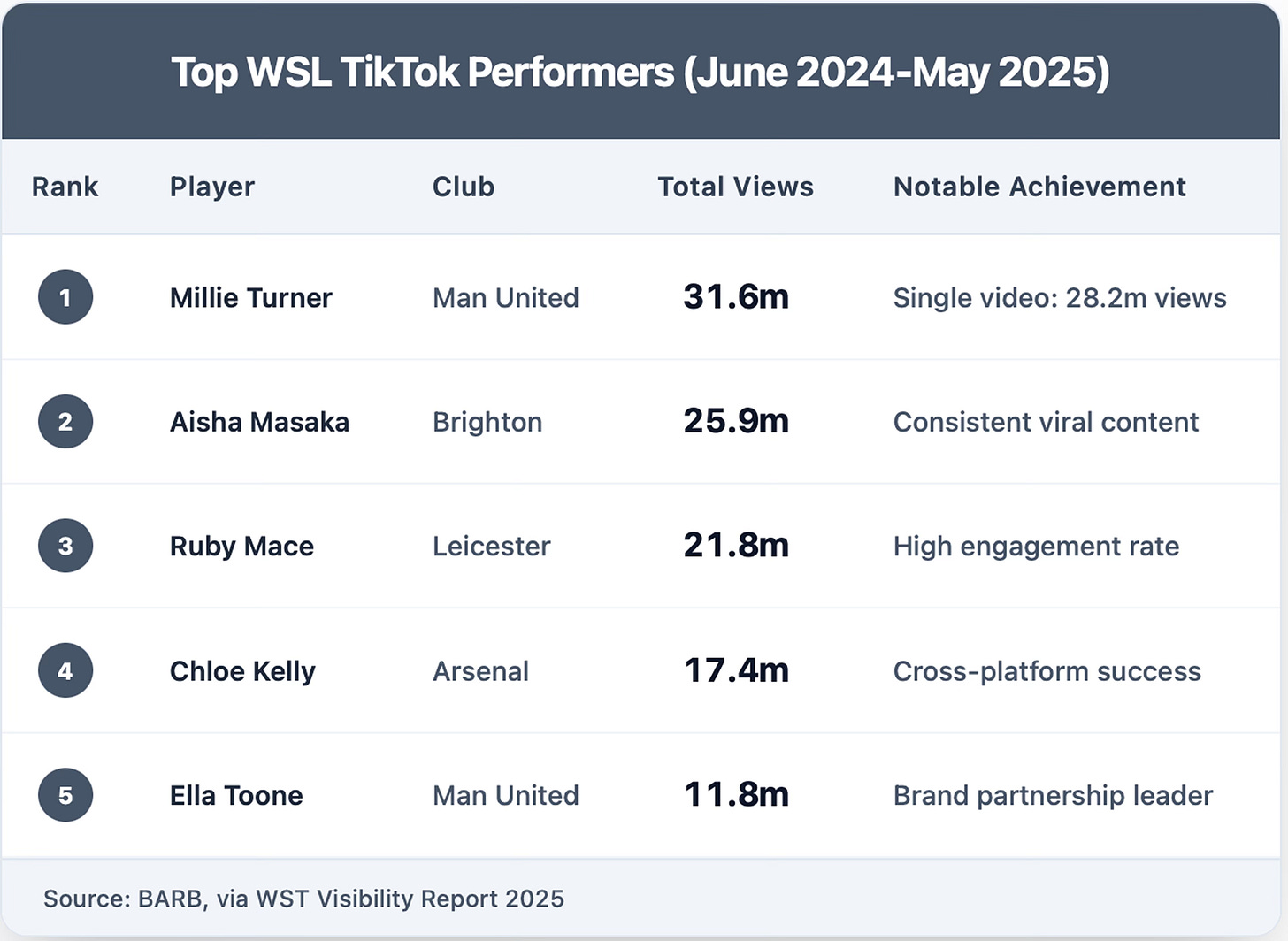
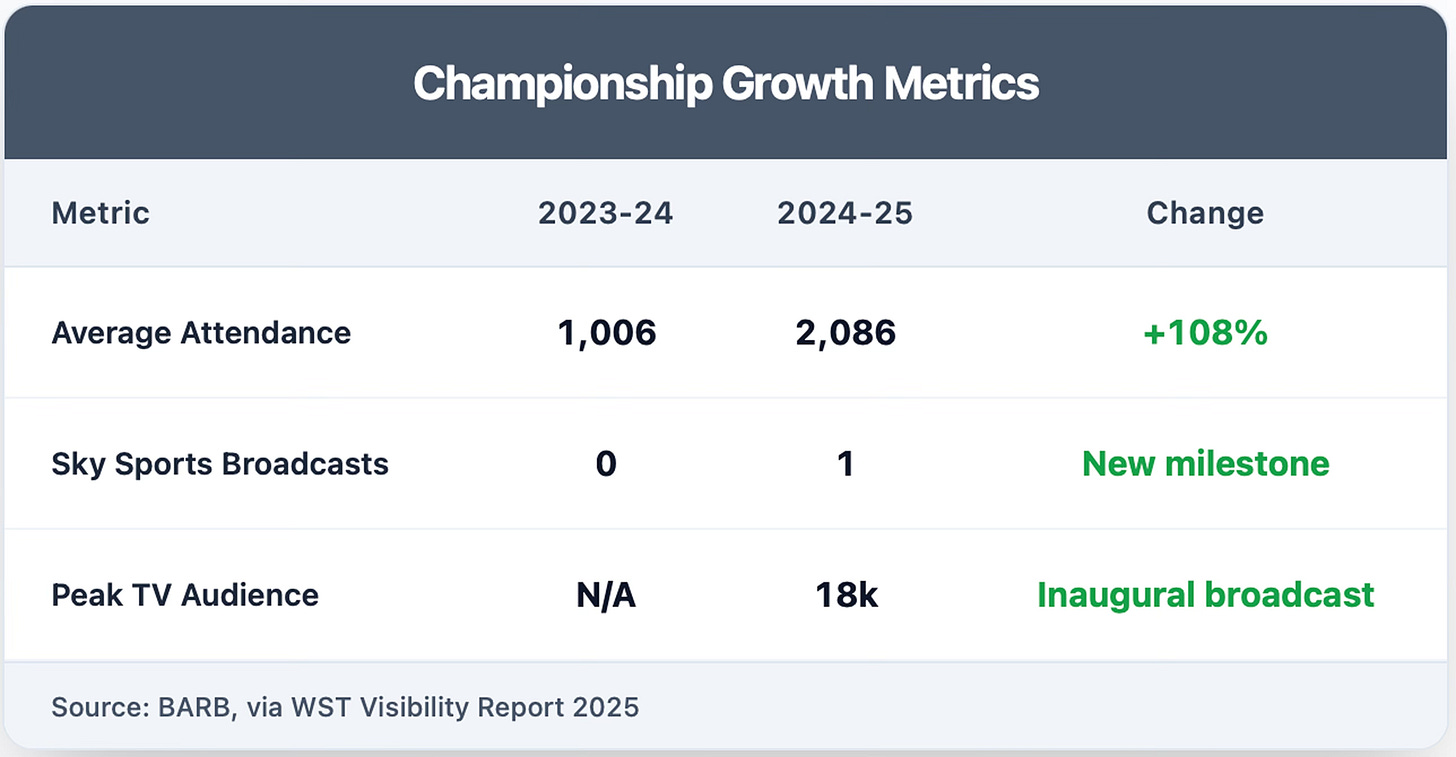
What an amazing article. You took what was a headline posted by other journos and provided clear and comprehensive analysis. Thank you for this deep dive.